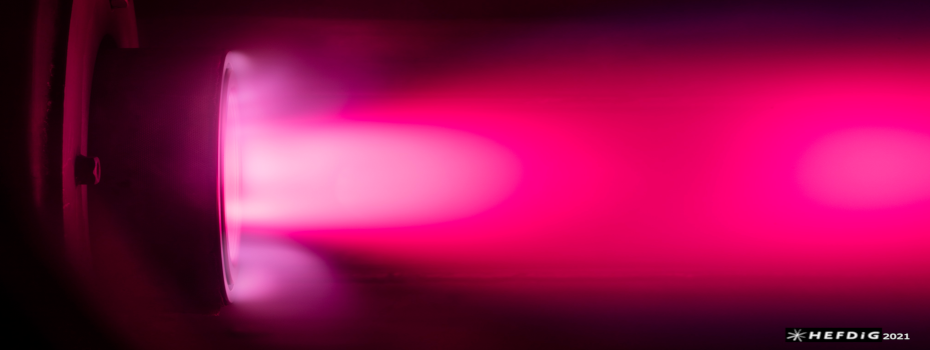Speaker
Description
As a vehicle re-enters the Earth’s atmosphere, it will be travelling at hypersonic speeds through the quiescent atmospheric gas for the majority of its journey. Consequently, a bow shock forms ahead of the vehicle, creating a sudden temperature and pressure increase. The post-shock temperatures are high enough to excite internal energy modes of the gas particles and promote dissociation and ionisation reactions. Radiation is then emitted as the high temperature gas tries to attain a new state of thermodynamic equilibrium.
High enthalpy ground testing facilities play a pivotal role in the advancement of understanding shock layer thermochemistry and subsequent radiation emission ahead of an entry vehicle. These effects are critical to understand the convective and radiative heat loads during planet re-entry. Two types of such facilities are shock tubes and plasma torches. The Oxford T6 Stalker Tunnel [1, 2] is a transient facility, able to recreate both the high temperature and aerodynamic environment of the shock layer flow field, though limited to test times on the order of micro-seconds. A recent study by Glenn et al. [3] has acquired data in synthetic air for shock speeds from 5.5 to 7.2 km/s while operating in Aluminium Shock Tube (AST) mode, with post-shock pressure close to 1 bar. Simulations run using NASA’s NEQAIR radiation code [4] underpredict the experimental data. This discrepancy is identified to not be a result of shock deceleration effects, which is fairly minimal for the considered test cases.
In contrast, the École Centrale inductively coupled plasma (ICP) torch is another type of ground test facility capable of reproducing the high static enthalpies experienced in the shock layer of an entry vehicle, though is restricted to subsonic flows and atmospheric pressure. The continuous operation allows for extremely long camera exposure times, ideal for high resolution spectral data [5]. Previous studies have shown the ICP torch to be in a state of local thermodynamic equilibrium [6], making it a good comparison for equilibrium radiance data at atmospheric pressure. Simulations using the SPECAIR radiation code [7] generally show very good agreement to the high resolution spectral radiance data after reconstructing the line of sight across the plasma diameter.
The post-shock temperatures of the 5.5-7.2 km/s T6 AST shots are in the range of temperatures present across the ICP torch plasma diameter. Thus, the same radiating species will be present. Direct comparison between the two facilities can not be made due to the different thermodynamic and aerodynamic environments. Instead, comparisons are performed using the NEQAIR and SPECAIR radiation codes after reconstructing the line of sight through the centre of each facility. Comparison of spectra from each facility to NEQAIR/SPECAIR predictions in the ultraviolet/visible range will provide valuable insight to both the thermochemical processes occurring within air shock layers ahead of entry vehicles, the performance and characteristics of data obtained from each facility type, as well as the capabilities of the two radiation codes.
The full paper will present experimentally attained spectral radiance from both facilities in the UV/Vis range, along with NEQAIR and SPECAIR simulation results.
References
[1] Collen, P., "Development of a High-Enthalpy Ground Test Facility for Shock-Layer Radiation," Ph.D. thesis, Univ. of Oxford,, Oxford, UK,, 2021.
[2] Collen, P., Doherty, L. J., Subiah, S. D., Sopek, T., Jahn, I., Gildfind, D., Penty Geraets, R., Gollan, R., Hambidge, C., Morgan, R., et al., "Development and commissioning of the T6 Stalker Tunnel," Experiments in Fluids, vol. 62, no. 11, pp. 1-24, 2021.
[3] Glenn, A. B., Collen, P. L., and McGilvray, M., "Experimental Non-Equilibrium Radiation Measurements for Low-Earth Orbit Return," 2021.
[4] Whiting, E. E., Park, C., Liu, Y., Arnold, J. O., and Paterson, J. A, "NEQAIR96, Nonequilibrium and Equilibrium Radiative Transport and Spectra Program: User’s Manual," 1996.
[5] Casses, C. J., Bertrand, P. J., Jacobs, C., Macdonald, M. E., and Laux, C. O, "Experimental characterization of ultraviolet radiation of air in a high enthalpy plasma torch facility," Progress in Flight Physics, vol. 7, pp. 353-368, 2013.
[6] Laux, C.O., "Optical diagnostics and radiative emission of air plasmas," Ph.D. thesis, Stanford university, 1993.
[7] Laux, C. O., Spence, T., Kruger, C., and Zare, R., "Optical diagnostics of atmospheric pressure air plasmas," Plasma Sources Science and Technology, vol. 12, no. 2, p. 125, 2003.
Summary
Equilibrium radiance spectra from the Oxford T6 Stalker Tunnel and École Centrale inductively coupled plasma torch are compared to predictions from NEQAIR and SPECAIR radiation codes

